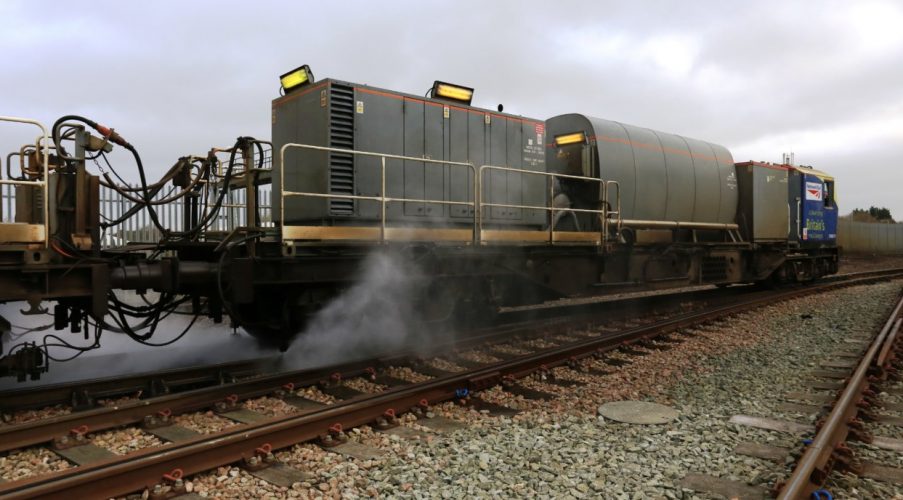There may be some truth in the suggestion that there are the wrong sort of leaves on the line, according to some new research into that annual headache for the railways.
Not that the railways have ever said that there are the wrong sort of leaves, it was BBC interviewer, James Naughtie who accidentally invented a meme when discussing train disruptions caused by heavy snow in 1991 and mentioned “the wrong sort of snow”.
Now the long-running stock joke about the railways could go the way of the British Rail sandwich, as research has uncovered why some leaves cause more problems than others.
The problem occurs when damp autumn leaves fall onto the railway and are crushed into a surprisingly difficult to shift black paste that caused the train wheels to slip and lose adhesion to the railway tracks. This means train drivers must slow down earlier for stations and signals to avoid overshooting them. It can also affect trackside signalling causing problems in knowing where trains are and running the service safely.
Newer trains also suffer more than pre-1980s trains as the older trains used to slow down by pushing a brake shoe against the edge of the wheel, which has the accidental additional benefit of cleaning the outer edge of the wheel to remove the leaf sludge. Modern trains use brake discs which are more effective and require less maintenance but do lack that secondary benefit of cleaning the outer edge of the train wheels.
Leaf fall is not just a problem in causing delays, but also expensive as those slipping wheels need more regular regrinding to keep them circular, and if trains have to be taken out of service for repair, more delays for passengers.
So serious is the problem that the railways have to switch to autumn timetables to cope and run special engineering vehicles along the lines to blast the oily residue off the tracks.
Network Rail has 61 leaf-busting trains, which move around the network cleaning the rails and laying adhesion modifier – a composite material of sand and steel shot suspended in a gel-like substance, which is applied to the rail to clear the tracks and help ensure the signalling system works correctly. They also need to keep 80 leaf-busting teams at key locations to scrub the top of the rails by hand with a sand-based treatment.
It costs around £60 million a year to try and clear the lines and deal with the damage to trains.
Studying the effect is as difficult as dealing with it, thanks to the huge variety of trees and plants that line the railways and the manifold different weather conditions which might affect how this black sludge is formed.
The railway knows that there are six trees that seem to cause the worst problems, Ash, Sycamore, Poplar, Lime, Sweet chestnut, and Horse chestnut –which make up around 40% of the trees lining the railways in England. The problem is less acute in Scotland, where the dreadful six account for 24% of their trackside trees.
The difficulty in dealing with the problem was that they knew some trees seems worse than others, but no one was entirely sure why these six were so much worse than the others. Just cutting them down might not fix the problem if the tree types were only a contributor to the problem.
Researchers decided to focus on the sycamore trees which are one of the more popular lining the railways in England. They tested them by leaving leaves from sycamore trees in water overnight to develop the autumn wetness, then adding the iron commonly found in train tracks to the leafy soup.
This caused a fast reaction resulting in a black fluid which was particularly slippy when tested and matched many of the descriptions of the black material found on the railways.
A number of leaf solutions were then treated to remove some of their compounds, to see what chemicals in the leaf causes the reaction, and they found that it was the presence of high levels of tannins in the leaf that cause it to react with the iron in the rail track and create the slippy gloop that infuriates the railway companies.
What is being suggested is that new planting along railway tracks should aim for plants that are naturally low in tannins so that their leaf fall in the autumn won’t affect the railways.
That requires more research to work out what plants would be suitable, and also to be sure there aren’t any other factors that occur outside the lab on live railways.
The findings are unlikely to reduce the number of trees that need to be cut down to reduce the problem today, not just because the wrong sort of trees were planted in the past.
But, because large heavy trees occasionally fall over blocking the railway — and then you really do have a problem with the wrong sort of leaves on the line… they’re still attached to the tree.
Due to a tree blocking the railway at Gerrards Cross all lines are blocked.We are currently working to get this removed. pic.twitter.com/PRMe0DOTKC
— Chiltern Railways (@chilternrailway) July 20, 2017
The full paper: The composition and friction-reducing properties of leaf layers, by Michael Watson, Benjamin White, Joseph Lanigan, Tom Slatter and Roger Lewis has been published in the Proceedings of the Royal Society and is available here.







